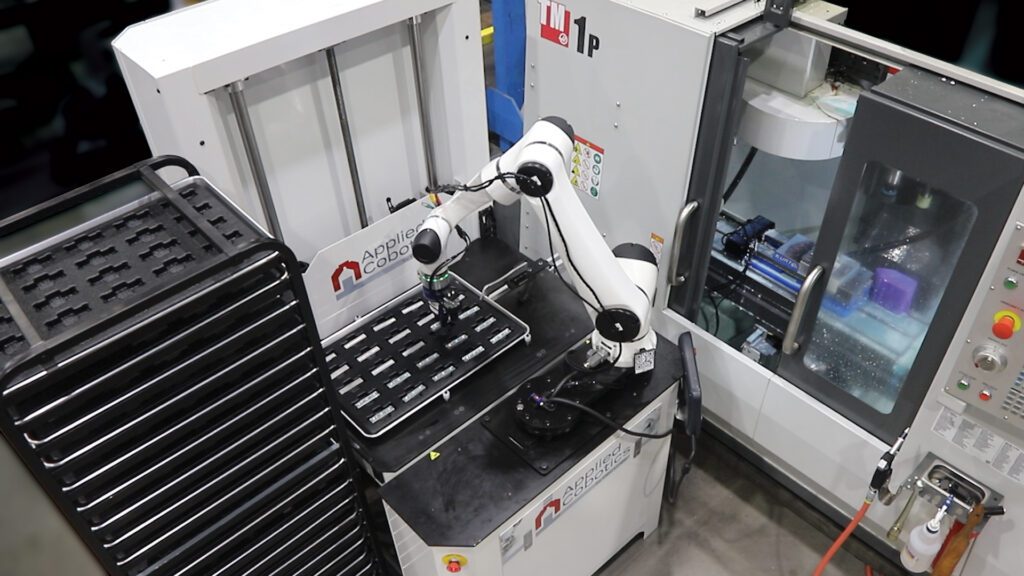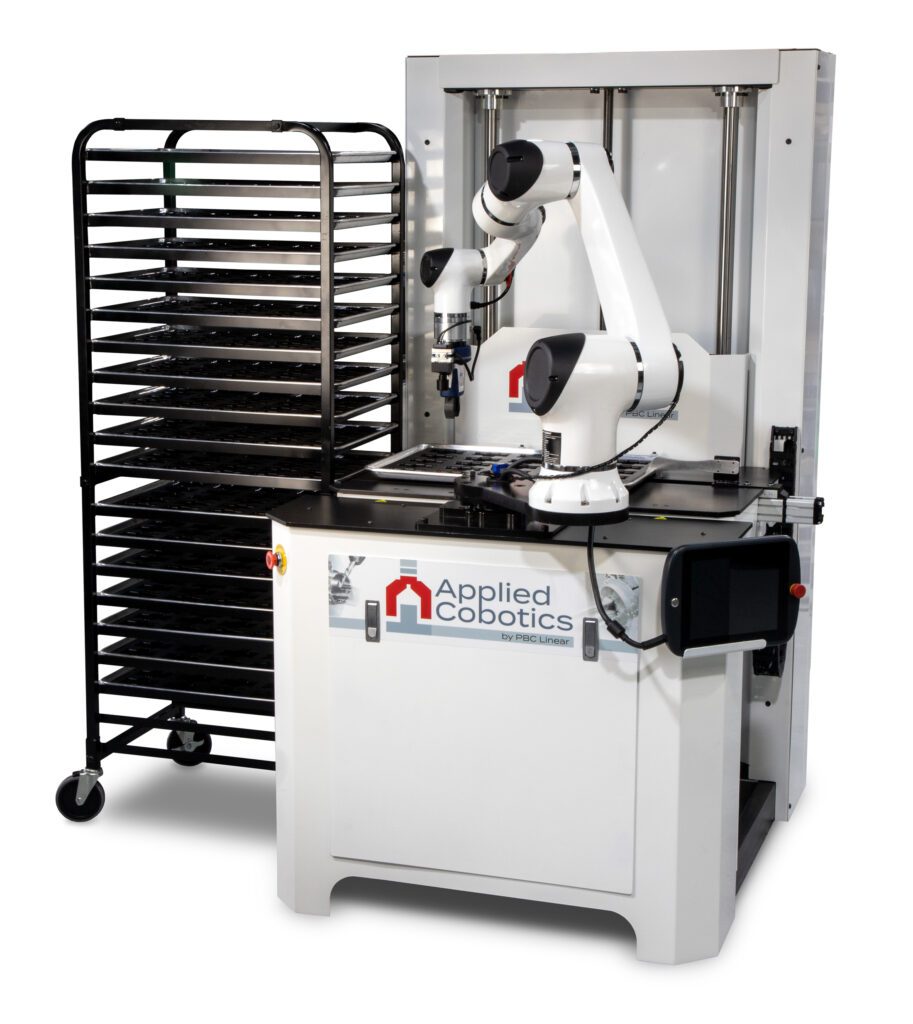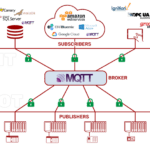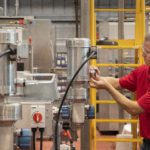In this article, we detail how assembly, packaging, and machine-tool OEMs can keep senior plant personnel in charge of the most demanding and intricate tasks — and relegate everything else to pre-programmed work routines and automated workcells. Such approaches make copious use of cobots and augmented reality (AR) tools.
By Tim LeCrone • Director of Research, Development, and Customer Outreach | PBC Linear • Applied Cobotics
Elisabeth Eitel • Executive Editor | Design World
The ultimate question for today’s plant managers is this: How should an organization protect the valuable time of its most seasoned machine operators and engineers by keeping them on sophisticated tasks — and leverage complementary tools such as collaborative robots (cobots) and augmented reality (AR) to delegate everything else?
Both cobotics and AR tools help manufacturers match employees with tasks that best fit individual skillsets — to leverage the full promise of the Factory of the Future. To illustrate, cobots can act as a support for seasoned employees — freeing them to simultaneously tend multiple machines. AR tools can guide new hires through complicated but well-defined routines for autonomy and efficient on-the-job learning.
Following are five ways to identify application tasks where cobotics and AR tools make the most sense — and maximize returns on investment (ROI) for new purchases of these technologies.

1. Run employee productivity calculations
All business operations should have in place some way of quantifying employee productivity. In industrial and manufacturing settings, this typically takes the form of simply tracking revenue or (especially in larger companies) counting the routines or workpieces output (sans flaws) completed per day or hour.
Software tools abound to compare these outputs to a moving baseline over time. Where appropriate, this information might even display on visual management displays such as bulletin boards or overhead flatscreens exhibiting key performance indicators or KPIs for all employees to note and stay well informed.
The most useful measures of productivity account for the time and effort each subtask requires for a given operator execute a complete process. Such measures along with employee feedback can help identify complicated, fatiguing, mundane, and otherwise subtly demoralizing tasks that may in fact be better run by a cobot or enhanced with AR tools.
Once all the areas of rote-tasks slowdowns are identified, manufacturer-supplied and industry-association online calculators abound to calculate the ROI on a given cobot or AR-tool installation — and identify where blended operations (including both automated and manually executed tasks) make the most sense.

Case in point: As we’ll detail, faster cobot ROI is possible if a given robotic workcell runs more than one shift per day and where labor and labor-turnover costs are high. The use of automated storage and retrieval (ASRS) tray-handling machines to complement the work of a cobot also shortens the ROI timeline. On the other hand, high electrical-utility costs can yield a slightly longer ROI timeline.
2. Determine where cobot ROI won’t and will be impressive
Cobots have become exceptionally practical over the last few years. However, there’s a big difference between purchasing a cobot arm and fully integrating that arm into factory operations. What workcells should get cobot arms first? What functions should they assume? As with any technology for captive plant use, cobots yield the highest ROI when they’re targeted to the most appropriate applications … and complemented by automated modules and software-driven tools.
Consider how there are numerous ways to automate robotic workcells for machine tending, but hardest to automate are processes involving the picking and placing of workpieces. Machine vision is sometimes employed as a solution here. However, machine vision isn’t always successful in dealing with jumbled workpiece orientations for secure grasping — much less accurate placement into the equipment set to machine or otherwise process said workpieces. Despite the sensor and software developments of recent years, there aren’t yet affordable vision systems on the market that can reliably assist robot arms in picking parts out of a heap in a bin.
The vision-based solutions that prove most successful necessitate copious upfront programming by either an integrator or vision specialist — so make the most sense for high-volume operations.
In contrast, workcells that take a more pragmatic tack and present the robotic arm with workpieces in a more organized way provide quite speedy and dramatic ROI, even for more modest operations. That’s in large part because the technologies involved in this design are presently affordable and easy to configure and commission. Workcells built this way use a small amount of manual labor complemented by trays of workpieces and in some cases XYZ linear-actuated tray-handling machines along with collaborative robot arms to get the job done.
First, workpieces are manually loaded into thermoformed, injection molded, or 3D-printed trays called dunnage trays with cavities that are specifically designed to cradle and orient the workpieces in a prearranged way — an orientation that the cobot software expects. Then these trays are either:
• Manually placed (one at a time) at a preset cobot-reachable location by a machine operator or
• Manually loaded into a rack that accommodates a whole stack of workpiece-laden trays — which in turn is accessed by a standalone XYZ linear-motion ASRS module that presents trays one at a time to the cobot.
From here, the cobot (fitted with an appropriate gripper) nimbly and reliably plucks unfinished pieces one at a time from the current tray to allow the execution of some machining or assembly task — and then (usually) replaces that finished part back in the tray. Then the cobot repeats this cycle until all the workpieces in the tray have been processed and it’s time for a fresh tray.

Workcells incorporating an ASRS tray module rely on linear motion actuation to regularly present the cobot with fresh trays. In most cases, the cobot picks workpieces to feed them into (and then remove them from) a machine it’s tending. Programming containing net profiles helps the robotic arm recognize the workpieces as they lay in the dunnage trays and as they appear when secured in the tended machine.
A cobot-based automated workcell of this type run just one shift per day can pay for itself in about three months.
Cobot installations can help address the challenges of labor shortages by executing the tasks associated with hard-to-fill employee positions.
Don’t underestimate the importance of gripper design: One component that is key to maximizing the ROI on such cobot installations is the end effectors known as grippers — both standard and customized. Though two-finger (also called parallel) grippers are by far the most common robotic end-effector solution, three-finger grippers are also common — and somewhat more reliable for grasping workpieces with unique geometries. No wonder three-finger pneumatic grippers on cobot arms are so often found servicing workpieces loaded into dunnage trays (just described) for part orientation. Otherwise, particularly challenging workpiece shapes are best handled by cobot arms sporting grippers having custom 3D-printed fingers to mate with or otherwise positively engage workpiece geometries. Once such gripper fingers are designed, myriad copies can be 3D printed to support expanded operations in cloned workcells.
Turbo speed ROI with ASRS modules: The cobot installations most capable of addressing serious labor issues are those that can run unattended the longest — as in setups that regularly present the cobot with 30, 40, or 50-part trays. Especially in machine shops and assembly operations, tray-lift ASRS modules that can automatically present trays to a cobot (as described above) can extend the time for which a workcell can operate unattended to eight hours and beyond.


3. Boost ROI with AR for installation, training, and onboarding
Augmented reality or AR is another tool to complement collaborative personnel-technology settings — namely by:
• Helping plant managers leverage the knowledge of suppliers to install and configure a new cobot installation in mere hours
• Training longtime personnel as well as new hires on how to work alongside automated cobot-based designs
• Helping plant operations avoid the wastefulness of duplicating efforts — especially in adjusting workcell settings and training new hires.
Without leveraging supplier knowledge (via AR or other means) properly configuring a cobot installation can take weeks of trial and error, debugging, and programming. In contrast, AR-based directions streamline all these steps. In short, a technician wielding an iPad or wearing an AR headset or goggles follows directions communicated through the tablet or goggles and superimposed upon his or her own incomplete cobot setup. These directions are written by the cobot-solution supplier to indicate key points for initial cobot configuration.
In addition, AR tools can help address any trepidation or reluctance of machine operators to accept new cobot cells in their work environment. Once machine operators and other factory workers are familiarized (via AR) with how to command cobot operations, the latter can free them from having to manually execute dirty, dull, and dangerous tasks. Without the burden of monotonous jobs, operators are freed to spend more time on higher-level tasks (such as checking parts and getting material ready for the next batch of processing). Throughput is higher — and job satisfaction with it. That’s especially true where cobot installations are left to run overnight to tackle a few hours of extra rote work … and give workers in the morning a head start on the day.
As mentioned, employing AR-based training tools can help attract, onboard, and retain new hires even fresh out of high school. That’s especially important for the machine-tool industry and related fields that currently face shortages of vocationally trained talent … and cannot spare the time of more seasoned personnel to onboard all new hires — especially if there is any amount of significant turnover in the positions. Such AR-based training can also appeal to new collar workers — contemporary technology workers who eschew traditional four-year degrees for less formalized educational paths.

Consider how even before COVID, some manufacturing industries (including the machine tool and packaging industries) faced low workforce applicant and entry numbers. Traditionally, new hires in these industries would be paired with an experienced person to shadow for six or more months — just to learn all the functions and proper settings of all a job’s involved machines. Now, today’s labor shortage has necessitated faster upskilling — beyond anything that traditional one-on-one workforce mentoring can achieve. No wonder AR tools such as Manifest software from Taqtile have seen increased use over the last couple years especially.
Such AR software lets plant managers coauthor (with experienced machine operators) very specific machine-operator instructions for very specific jobs to be run on a given machine. Then new hires can don AR goggles to follow along and execute these specific tasks — in some cases, becoming productive plant-for employees in just a few hours. In other instances, AR tools might allow operators to scan QR codes on the machine to get instruction sets.
Such AR training also makes sophisticated machine-tool and other manufacturing operations less intimidating and more approachable and enjoyable for new hires — especially those who have come from warehouse-fulfillment jobs. That in turn supports more local manufacturing to curb transport-related supply-chain issues.
Of course, ideally such fast-track training tools should complement longer-term mentorships catered to those in the workforce who remain with a company and find inspiration for a sustained career in the industry.
Some AR software can be programmed to display simple instructions for a new operator to follow along. Over time, new hires learn from these instructions and gain on-the-job training.
Onboarding new hires with AR-guided tasks can also help plant operators avoid losses associated with intensively training new personnel in positions subject to high turnover. That’s especially true where new hires might (with just a few months’ shadowing a seasoned journeyman CNC machinist, for example) be able to interview with a competitor company and demonstrate enough machine-operator proficiency to get hired.
In fact, AR can also help orient mechanical-engineering interns to execute office work — such as CAD of workpieces, for example. Where manufacturers connect with and hire local engineering students, they can often help their local community instead of losing them to other states or regions. It frees staff engineers and managers to run higher-level business projects.
4. Quantify the total price of cobot and AR adoption
Calculating ROI for any workcell enhancement (including that with robotic operation or AR guidance) should also consider estimated costs relating to:
• Engineering and plant-floor reconfiguration efforts
• Workcell downtime and integration
• Safety-certification costs
• Programming and personnel training costs.
Besides machine tending, cobots are suitable for conveyor tending — especially where conveyors move parts from one machine to another or a given machine is conveyor fed.
After all, the longer a plant-floor reconfiguration takes, the more disruptive it can be — especially where affected workcells are central hubs in the flow of materials through a plant … and where they involve several operational systems and plant teams. That’s why workcell re-integration should be executed by experienced integrators or leverage technologies designed for straightforward installation and commissioning.
In fact, AR and cobot technologies leverage software to minimize the burden of all these factors. Consider one last feature of cobots that renders them particularly suitable for addressing labor-force pressures with minimal disruption for commissioning. Cobots from Elfin, Universal Robots, Fanuc, and other suppliers can all operate blindly — a mode in which the cobot does everything a human operator would do. For example, in cobot tending of a CNC machine, blind operation includes picking up parts; opening machine doors; loading parts into a machine; closing machine doors; and even depress machine Cycle Start buttons. The conversational programming of these cobots makes setups of these functions relatively easy.
AR and cobot technologies are also inherently safety-focused — with software to minimize complex programming and training requirements as well.
5. Leverage AR-assisted quality control
Many tasks (especially those associated with quality control) are still most efficiently and reliably done manually. That could change over the next few years — though not anytime in the immediate future for small and midsize companies. As mentioned earlier in this article, the cost of machine-vision programming and hardware for these tasks remains prohibitively expensive for many operations.
Fortunately, both cobotics and AR tools can help manufacturers consistently produce the highest-quality product by speeding manual inspection tasks — and yielding ROI even for these tasks. For example, a manufacturer might photograph a perfect part and provide that image to machine operators via an iPad running an AR app. These machine operators can then reference the perfect part image while unloading trays of the same part — to check for the presence and consistency of specific holes, bolts, or other subelements. Or the machine operator might just do a spot check on the last part in the tray to ensure it has all the features pictured on the iPad reference image … for speedier execution of a process that must be done very carefully but quickly.
PBC Linear • Applied Cobotics | appliedcobotics.com







Leave a Reply
You must be logged in to post a comment.